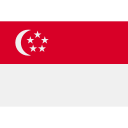Trusted platform, secured by
Why Land Matters to Singapore?

We shared a lot about how Singapore found space for its future, either through exploring the underworld, on the sea, or in the air. There is one thing that Singapore is never stopped doing is expanding the land via land reclamation.
Thus, why land size expansion is so crucial to Singapore?
“Just imagine that Singapore has a similar annual Gross Domestic Product with Malaysia, but its land size is merely 0.2% of the total land size of Malaysia”
If you refer to the below comparison of Singapore's historical GDP with Singapore's land size growth since the 1960s, both graphs are growing in parallel and share a very similar trend. It shows how the land size is so vital to Singapore's economic growth.
Learn the Introduction of Key Construction Equipment here.

With Singapore's small land size of 590 sq km2 upon independence, it is almost a mission impossible for Singapore to develop and sustain growth with its limited land size. There is no other better choice but to grow its land for its development of infrastructure, buildings, and industrial areas to cater to more population and industrial expansion.
Singapore’s land reclamation history is never been a recent story but has already started in the past two centuries. Since its independence in 1965, Singapore has grown from around 590 km2 to 720 km2 in 2014, reclaiming an estimation of 22% of its total ground area from the sea. It is estimated Singapore expanded its size by 25% of its original land size two centuries ago.
Some other countries' reclaimed land size is much more than Singapore such as China and Holland. However, they have a much larger original land size than Singapore.
It makes Singapore the largest reclaimed land by original size in the world!

The above map shows the current reclaimed land (pink shaded) and planned future reclaim area till 2030 (red shaded). There is still a lot of land that Singapore plans to create.
In Singapore, there are basically three other government agencies that help Singapore to oversee and create land. They are Jurong Town Corporation (JTC) and the Maritime and Port Authority of Singapore (MPA) and the Housing Development Board (HDB). They all cover the areas of Jurong & Tuas Industrial, Changi Airport area, Maritime Port, and others respectively.
Land for Singapore's Future
It is certain that the reclamation will never stop to meet the demand of its growing population and economy. Urban Redevelopment Authority projecting an additional 100km2 of land to be reclaimed by 2030 in order to accommodate the population growth from the current 5.6mil to 6.5 and to 6.9 mils in 2030.

Singapore is looking at other ways of maximizing its land space. This includes the development of reserve land, intensifying land usage in new developments, and reusing and rezoning old industrial areas and golf courses for more productive purposes.
Here are some of the reclamation timelines in Singapore. Of course, the projects were not limited to as follows:
Boat Quay: The First Reclamation Project (around 1819)

Collyer Quay: Creating the Waterfront (the late 1860s)

East Coast to Marina South: The Great Reclamation 1963


New Lands for Industries: JTC (1963) Jurong Island and Tuas

Changi Airport Area Reclamation (1975)

Pasir Panjang Terminal (1971)
CHECK EQUIPMENT RENTAL RATE INSTANTLY
Remember to Like and Follow us on Facebook! bit.ly/34MdSFh
Any Questions?
WhatsApp or Call Us for a FREE consultation on the most suitable equipment for your site. We’re more than happy to assist!
Related Articles

Top 5 Common Construction Safety Issues & Mitigation Plans in Construction Industry
Construction sites are dangerous places. Some of the dangers, such as heavy cons ...
Learn more
11 May , 2025

Do you know who is the top 10 biggest construction equipment rental companies in the world?
According to the ranking published by International Rental Magazine based on tur ...
Learn more
11 May , 2025

Boom Lift Rental Rates in Malaysia: How Much Does It Cost?
Malaysia's booming industries and construction sites require frequent work at he ...
Learn more
11 May , 2025

Ultimate Guide To Rent Concrete Pump Trucks In Singapore
In the fast-paced construction industry of Singapore, efficiency, quality, and s ...
Learn more
11 May , 2025



.png)













